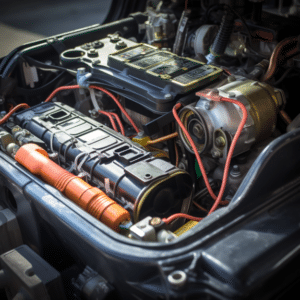
Car Battery Troubleshooting: Tips for Diagnosis and Prevention

Troubleshooting car battery issues is essential. A car battery is vital for a vehicle’s functioning, so identifying and solving any issues is key.
Common signs of a battery issue are:
- Difficulty starting the car
- Dim headlights
- Intermittent power loss in electric components
To get to the root cause, one must consider the age of the battery. Batteries may need replacement as they lose efficiency over time. You can check the battery’s production date or ask a professional to determine if age is a factor.
Now for a fun fact – back in 1800, Alessandro Volta invented the “Voltaic Pile” – the first true battery. This discovery led to immense advancements in battery technology, bringing us to where we are today with automotive batteries.
Understanding car battery problems
Car batteries can have issues, leaving you without power to start your car. Knowing about these problems is essential for every driver. No one wants to be stuck in the middle of nowhere with a dead car!
Signs and symptoms of a car battery problem
Car batteries can cause issues, but how do you know when? Let’s explore the tell-tale signs.
- Dim headlights? A weak battery leads to less bright headlights. Low on power, it can’t provide enough energy.
- Slow engine crank? A weak battery stops the engine cranking quickly. A healthy one gives out enough power.
- Electrical issues? If lights flicker or power windows don’t work, it’s a sign of a failing battery. Disruption in voltage is the cause.
Other unique details too: temperature can affect battery performance. Hot and cold both add strain and lessen lifespan.
John’s story acts as a reminder. His car wouldn’t start on a winter morning – the battery dead from the cold. He had to call roadside assistance and replace it; costing him time and money.
Be aware of dim headlights, slow starts, electrical issues, and temperature. Keep prepared – it’ll save you trouble on the road!
Step-by-step troubleshooting guide
Ever been in a situation where your car won’t start? Worry not! This guide will help you identify and solve car battery issues.
1: Check the battery connections.
- – First, locate the battery under the hood.
- – Ensure the connections are secure and not corroded. If so, clean with a wire brush.
- – Inspect the battery cables for damage or wear. Replace if needed.
2: Test the battery voltage.
- – Use a multimeter to measure the voltage. Should be 12.6 volts. Lower readings mean the battery needs recharging or replacing.
3: Examine the battery for damages.
- – Check for bulges, cracks, or leaks. If any, replace the battery ASAP.
4: Jumpstart or recharge the battery.
- – If the battery is low on charge but still in good condition, jumpstart with jumper cables and another vehicle’s fully charged battery.
- – Or, recharge the dead or weak battery overnight with a battery charger.
Remember to:
- – Wear protective gloves and eyewear when working with batteries.
- – Follow proper disposal procedures when replacing old batteries.
My friend Lisa had a similar issue a few years ago. Her car wouldn’t start before an important meeting. After following these steps, it turned out the issue was loose battery connections. She just had to tighten them and the car started. It shows how important it is to understand and troubleshoot car battery problems!
Common causes of car battery problems
Car battery issues can be an annoyance. It’s wise to understand the typical causes to help prevent them.
- 1. Age: Batteries generally last 3-5 years, so keep track and replace it before any problems arise.
- 2. Temperature: Extreme heat or cold can harm the battery.
- 3. Lights/Accessories: Leaving them on can deplete it.
- 4. Charging system: An issue with the alternator can decrease its charge.
- 5. Parasitic drain: Bad switches or aftermarket accessories can drain it when off.
Remember to regularly check the battery and clean the terminals. This will help you avoid unexpected breakdowns. Plus, prevention is better than cure when it comes to maintaining your car’s battery. Take charge today for worry-free journeys tomorrow!
Preventive measures to avoid battery issues
Stop car battery troubles by taking preventive measures. Follow these steps to extend the life of your battery:
- Clean terminals regularly
- Turn off all electrical equipment when the engine is off
- Ensure proper insulation and secure mounting
- Disconnect the battery if not using for a long time
Remember, batteries usually last 3-5 years. Replacing it early can save you from sudden issues. Furthermore, keep an eye out for signs of a weak battery such as slow engine starting and dim headlights to detect problems early on.
John’s story in 2015 proves the power of preventive measures. He faced frequent battery failures but, after researching and implementing the right measures, the issue vanished!

Conclusion
Troubleshooting a car battery issue involves careful analysis and diagnosis. This article outlines steps to identify and fix the problem. A failed battery can have many causes like loose connections or a faulty charging system.
- Begin with a visual inspection of the battery terminals. Look for corrosion and loose connections. If necessary, clean the terminals using a wire brush and securely tighten them.
- Use a multimeter to test the voltage of the battery. A fully charged battery should read around 12.6 volts. Anything lower means the battery needs charging or replacing.
- Check the alternator output using a voltmeter when the engine is running. A healthy alternator should produce 13-14 volts. Lower readings indicate an issue with the alternator or its components.
- Test the parasitic draw on the battery when not in use. Disconnect all electrical devices and measure the current between a disconnected cable and its post on the battery using an ammeter. Excessive current draw needs further investigation to find and fix any wiring faults or malfunctioning components.
Prevent future battery problems by regularly checking for loose connections or damaged cables. Also, let your car run for longer periods at certain intervals to let the alternator recharge your battery.
By following the steps and suggestions, you can Car battery troubleshooting problem and decide whether to replace or repair it. Remember to wear protective gear and work in a well-ventilated area for safety.
Frequently Asked Questions
Q: How do I know if my car battery is dead?
A: You can check for signs such as dim headlights, difficulty starting the car, or a clicking sound when you turn the key.
Q: What should I do if my car won’t start?
A: First, check if your battery connections are secure and clean. If that’s not the issue, try jump-starting your car with jumper cables or calling for roadside assistance.
Q: Can extreme weather affect my Car battery troubleshooting?
A: Yes, extreme cold or heat can cause changes in the battery’s chemistry and reduce its performance. It’s important to take preventive measures, such as keeping the battery terminals clean and parking in a garage during extreme temperatures.
Q: How long should a car battery last?
A: On average, a car battery can last between 3 to 5 years. However, various factors such as climate, driving habits, and maintenance can influence its lifespan.
Q: What is the process of jump-starting a car?
A: To jump-start a car, you will need a set of jumper cables and another vehicle with a working battery. Connect the cables to the dead battery following the correct order of positive and negative terminals, then start the working vehicle and wait a few minutes before attempting to start the dead car.
Q: Can I replace a car battery myself?
A: Yes, replacing a car battery can be done yourself if you have the necessary knowledge and tools. However, it’s recommended to consult the vehicle’s user manual or seek professional help to ensure the correct installation and recycling of the old battery.
